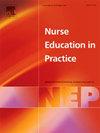Effectiveness of training for student midwives with jigsaw technique on respectful maternity care: A randomized controlled experimental study
IF 3.3
3区 医学
Q1 NURSING
引用次数: 0
Abstract
Aim
This study aims to fill this gap by evaluating the impact of Jigsaw learning on midwifery students' knowledge, practice and motivation in RMC training.
Background
While cooperative learning techniques have been explored in health education, their application in midwifery education—specifically in training student midwives in Respectful Maternity Care (RMC)—remains underexplored.
Design
It is a randomized controlled experimental study.
Methods
It was conducted between October 10, 2023 – January 5, 2024 with midwifery department students of a state university. The research was conducted according to CONSORT guidelines. The implementation phase of the study includes the announcement of the student groups (Jigsaw and control group), the study of the Jigsaw groups, RMC training, pre-test and post-test data collection.
Results
A significant difference was found between the post-test mean scores of the Jigsaw and control groups (p < .05) and the participants in the Jigsaw group had significantly higher "RMC" Knowledge and Application Scale, Motivation Scale for Teaching Material and Academic Motivation Scale mean scores than the students in the control group.
Conclusions
It was determined that the Jigsaw technique was an effective teaching method in increasing the RMC knowledge and practice levels of midwifery students. It was also determined that the motivation and academic motivation scores of the students in the Jigsaw group regarding the teaching material were higher than the scores of the students in the traditional teaching group and that the students found this technique quite effective.
一项随机对照实验研究:学习拼图技术的助产士在尊重产妇护理方面的培训效果
目的本研究旨在通过评估拼图学习对助产学学生在RMC培训中的知识、实践和动机的影响来填补这一空白。虽然合作学习技术已经在健康教育中进行了探索,但它们在助产教育中的应用,特别是在培训尊重产妇护理(RMC)的学生助产士方面,仍未得到充分的探索。设计:随机对照实验研究。方法于2023年10月10日至2024年1月5日对某州立大学助产系学生进行调查。这项研究是根据CONSORT指南进行的。研究的实施阶段包括学生组(拼图组和对照组)的宣布、拼图组的研究、RMC培训、测试前和测试后的数据收集。结果拼图组与对照组测验后均分差异有统计学意义(p <; .05),拼图组的“RMC”知识与应用量表、教材动机量表和学业动机量表均分显著高于对照组。结论拼图技术是提高助产学学生RMC知识和实践水平的有效教学方法。拼图组学生对教材的动机和学习动机得分高于传统教学组学生的得分,学生认为这种方法非常有效。
本文章由计算机程序翻译,如有差异,请以英文原文为准。
求助全文
约1分钟内获得全文
求助全文
来源期刊

Nurse Education in Practice
NURSING-
CiteScore
5.40
自引率
9.40%
发文量
180
审稿时长
51 days
期刊介绍:
Nurse Education in Practice enables lecturers and practitioners to both share and disseminate evidence that demonstrates the actual practice of education as it is experienced in the realities of their respective work environments. It is supportive of new authors and will be at the forefront in publishing individual and collaborative papers that demonstrate the link between education and practice.
 求助内容:
求助内容: 应助结果提醒方式:
应助结果提醒方式:


